Lithium Potential Mapping Using Artificial Neural Networks: A Case Study from Central Portugal
Abstract
:1. Introduction
1.1. Geological Overview of the Test Area
1.2. Remote Sensing Data
2. Data and Processing
2.1. Geological Data
2.2. Stream Sediment Data Processing
2.3. Exploration Model
2.4. Unclassified Factor Analysis
2.5. Sentinel-2 Imagery
- Super-resolving Sentinel-2 Multispectral Imagery to 10 m spatial resolutionThe low-resolution spectral reflectance bands (20 m and 60 m) were super-resolved to 10 m ground sample distance, using a convolutional neural network (CNN) as introduced by Lanaras et al. [43]. This approach extracts details from pixels with the highest resolution (four bands at 10 m resolution) and propagates these details to all other spectral bands (eight bands at 20 m and 60 m resolution) using the local consistency between neighbour pixels, to obtain an image where all spectral bands have a resolution of 10 m while preserving the spectral characteristics. This pre-processing step is useful for detecting features at the size of 200–250 m2.
- Dimensionality Expansion for Sentinel-2 Multispectral ImageryIn order to increase the multispectral data dimensionality and the performance of analysis (see Section 3), a method described in [44] to generate nonlinearly correlated spectral band images is implemented. For this purpose, suitable Sentinel-2 spectral bands for geological applications [33] are taken into consideration (Table 2).
2.6. External Data
- -
- Polygon features of urban areas, stored in the “landuse” layer;
- -
- Polygon features of water bodies, stored in the “water” layer, and;
- -
- Polyline features of the road infrastructure, stored in the “roads” layer.
2.7. Training Patterns
3. Methods: Prediction Modelling
- Collection of model input data, i.e., data that control the modelled feature (here the Li mineralisation) including geological units and structures (e.g., granite bodies, metamorphic sequences, pegmatites), selected stream sediment data, cloud-free pre-processed Sentinel-2 satellite imagery, and OSM topographical data (settlements, infrastructure, water bodies, etc.).
- Data processing of the spatial data to become suitable for use in analysing models, including the projection of input data to the project coordinate system, resampling to the specified spatial resolution according to project requirements, and clipping of input datasets to the extent of the project area as well as linear scaling of continuous raster data values between 0 and 1 and the conversion of discrete vector data into a binary raster with 0 and 1 value.
- Design of ANN models in the prediction software for different use cases, i.e., using different controlling parameters and suitable training patterns. The training patterns for remote sensing modelling are ideally in obvious spectral contrast to the surrounding environment and with distinctive spectral reflectance characteristics. The training scenario comprises the controlling and the network parameters (number of hidden layers, number of neurons for each layer, the maximum number of training epochs, etc.).
- Training of the ANN models using collected training patterns at the Bajoca Mine site, a well-known location for the presence of Li-bearing minerals. Other known locations (Feli and Alberto Mine) were used to validate the application model. The trained ANN will serve to identify similar Li-bearing pegmatite locations in unknown locations over the study area.
- Validation of the trained ANNs: There are several possibilities to evaluate the accuracy and reliability of a trained ANN by the identification of known locations that have not been used for network training (Feli and Alberto Mine), considerations of the network (MSE) error including statistical evaluation (histograms, all pixels vs. the positive pixels), and analysis of the model parameter weights. Typically, MSE errors below 0.2, balanced parameter weights, and a high probability of modelled pixels are indicators of stable and good neural network quality.
- Model application: After successful validation, the training network can be used in unknown locations for the prediction of similar events over the entire study area. The result is a distribution probability raster map.
- Refinement and presentation: The ANN classification results are irregular pixel-based raster data. In many cases, the classification results have to be further refined and processed to improve the cartographic representation of the result.
- The final distribution map of Li-bearing mineralisation: Combination of the distribution map result based on remote sensing data with the result obtained from modelling with geological and geochemical data. The combination of both geological and remote sensing data into one ANN model was tested, but it resulted in many false interpretations, as the controlling parameters refer to/explain different targets. Therefore, we chose the approach to merge the two ANN models only as a final step once distribution maps of Li-bearing mineralisation were created.
4. Results
4.1. Geological Model
- The network (MSE) error: The model error is shown in Supplementary Figure S3. Clearly, the model error converges after approximately 20 iterations and the final error is below 0.2, indicating that the neural network is stable and accurate. This means that the designed model was able to find correlations between the controlling parameters and the training data.
- Statistical evaluation: Additionally, the histograms (Supplementary Figure S3) reveal that the algorithm was able to identify >80% of the pixels in the training patterns with a scale better than 0.9.
4.2. Remote Sensing Models
4.2.1. Remote Sensing Model 1
- The network (MSE) error: The model error converges after approximately 40 iterations and the final error is below 0.2 (Supplementary Figure S4), indicating that the ANN is stable and accurate. This means that the designed model was able to find correlations between the controlling parameters and the training data.
- Statistical evaluation: The histograms (Supplementary Figure S4) reveal that the algorithm was able to identify about 90% of the pixels in the training patterns with a scale better than 0.9.
- The model parameter weights: The model weights confirm the Sentinel-2 visible (b2, b3, b4), NIR (b8, b8A), and SWIR (b11) spectral bands to be the most suitable for geological applications. On the other hand, the spectral bands in the red-edge part of the electromagnetic spectrum seem to be irrelevant for this application. The spectral bands with the highest weight contribution in the designed model are b2, b3, and b11. This is in accordance with Cardoso-Fernandes et al. (2019), who proposed the RGB combination Green–Blue–SWIR for the identification of Li mineralisation in the same region. The RGB composition out of b3–b2–b11 was further analysed in ArcGIS software 10.6 (Figure 6). Indeed, the well-known areas for Li mineralisation are successfully identified and highlighted compared to their surrounding environment. However, similar symbology is also assigned to other features with similar spectral properties as the target features.
- The distribution probability raster map: The prediction software delivers a distribution probability map in the value range of 0–1, illustrating locations of potentially identified Li-bearing pegmatites in the study area (Figure 6). With 1 are depicted areas with the highest probability to represent Li-bearing mineralisation. In the resulting map, pixel values with a probability value higher than 95% were assigned as “positive” locations. The threshold value is defined based on the histograms in Supplementary Figure S4.
Analysis of Spectral Signatures
4.2.2. Remote Sensing Model 2
- The network MSE error: A stable network MSE error that converges after 20 iterations and exceeds a final error lower than 0.001 (Supplementary Figure S7);
- Statistical evaluation: Similar plausible histograms as shown in Supplementary Figure S7;
- The model parameter weights: Distributed weights of controlling parameters. The combinations (b32), (b3 × b4), and (b8 × b11) were revealed to be significantly decisive for the prediction model.
4.3. Combination of the Geological- and Remote Sensing Models
5. Discussion
6. Conclusions
Supplementary Materials
Author Contributions
Funding
Data Availability Statement
Acknowledgments
Conflicts of Interest
Appendix A

References
- European Commission: DG Internal Market Industry Entrepreneurship and SMEs. Critical Raw Materials Resilience: Charting a Path towards Greater Security and Sustainability; COM(2020) 474 final; European Commission: DG Internal Market Industry Entrepreneurship and SMEs: Brussels, Belgium, 2020; p. 23.
- Brooks, K. Lithium Minerals. Geol. Today 2020, 36, 192–197. [Google Scholar] [CrossRef]
- Kesler, S.E.; Gruber, P.W.; Medina, P.A.; Keoleian, G.A.; Everson, M.P.; Wallington, T.J. Global lithium resources: Relative importance of pegmatite, brine and other deposits. Ore Geol. Rev. 2012, 48, 55–69. [Google Scholar] [CrossRef]
- Silva, D.; Lima, A.; Gumiaux, C.; Glouguen, E.; Deveaud, S. Spatial Geostatistical Analysis Applied to The Barroso-Alvão Rare-Elements Pegmatite Field (Northern Portugal). In GIS—An Overview of Applications; Teodoro, A.C., Ed.; Bentham eBooks: Sharjah, United Arab Emirates, 2018. [Google Scholar]
- Linnen, R.L.; Van Lichtervelde, M.; Černý, P. Granitic Pegmatites as Sources of Strategic Metals. Elements 2012, 8, 275–280. [Google Scholar] [CrossRef]
- Gourcerol, B.; Gloaguen, E.; Melleton, J.; Tuduri, J.; Galiegue, X. Re-assessing the European lithium resource potential—A review of hard-rock resources and metallogeny. Ore Geol. Rev. 2019, 109, 494–519. [Google Scholar] [CrossRef] [Green Version]
- Carvalho, J.M.F.; Farinha, J.A.L.B. Lithium potentialities in Northern Portugal. In Proceedings of the 17th Industrial Minerals International Congress, Barcelona, Spain, 28–31 March 2004; pp. 1–10. [Google Scholar]
- Roda-Robles, E.; Pesquera, A.; Gil-Crespo, P.P.; Vieira, R.; Lima, A.; Olave, I.G.; Martins, T.; Torres-Ruiz, J. Geology and mineralogy of Li mineralization in the Central Iberian Zone (Spain and Portugal). Miner. Mag. 2016, 80, 103–126. [Google Scholar] [CrossRef] [Green Version]
- Brown, W.M.; Gedeon, T.D.; Groves, D.I.; Barnes, R.G. Artificial neural networks: A new method for mineral prospectivity mapping. Aust. J. Earth Sci. 2000, 47, 757–770. [Google Scholar] [CrossRef]
- Rigol-Sanchez, J.P.; Olmo, M.C.; Abarca-Hernández, F. Artificial neural networks as a tool for mineral potential mapping with GIS. Int. J. Remote Sens. 2003, 24, 1151–1156. [Google Scholar] [CrossRef]
- Oh, H.-J.; Lee, S. Application of Artificial Neural Network for Gold–Silver Deposits Potential Mapping: A Case Study of Korea. Nat. Resour. Res. 2010, 19, 103–124. [Google Scholar] [CrossRef]
- Rodriguez-Galiano, V.; Sanchez-Castillo, M.; Olmo, M.C.; Chica-Rivas, M. Machine learning predictive models for mineral prospectivity: An evaluation of neural networks, random forest, regression trees and support vector machines. Ore Geol. Rev. 2015, 71, 804–818. [Google Scholar] [CrossRef]
- Roda-Robles, E.; Villaseca, C.; Pesquera, A.; Gil-Crespo, P.P.; Vieira, R.; Lima, A.; Olave, I.G. Petrogenetic relationships between Variscan granitoids and Li-(F-P)-rich aplite-pegmatites in the Central Iberian Zone: Geological and geochemical constraints and implications for other regions from the European Variscides. Ore Geol. Rev. 2018, 95, 408–430. [Google Scholar] [CrossRef]
- Catalán, J.R.M. The Central Iberian arc, an orocline centered in the Iberian Massif and some implications for the Variscan belt. Acta Diabetol. 2011, 101, 1299–1314. [Google Scholar] [CrossRef]
- Dias, R.; Ribeiro, A. The Ibero-Armorican Arc: A collision effect against an irregular continent? Tectonophysics 1995, 246, 113–128. [Google Scholar] [CrossRef]
- Bea, F.; Montero, P.; Zinger, T. The Nature, Origin, and Thermal Influence of the Granite Source Layer of Central Iberia. J. Geol. 2003, 111, 579–595. [Google Scholar] [CrossRef] [Green Version]
- Roda, E. Distribución, Caracteristicas y Petrogenesis de las Pegmatitas de La Fregeneda (Salamanca). Ph.D. Thesis, UPV/EHU, Bilbao, Spain, 1993. [Google Scholar]
- Roda-Robles, E.; Perez, A.P.; Roldan, F.V.; Fontan, F. The granitic pegmatites of the Fregeneda area (Salamanca, Spain): Characteristics and petrogenesis. Miner. Mag. 1999, 63, 535–558. [Google Scholar] [CrossRef]
- Vieira, R. Aplitopegmatitos com Elementos Raros da Região Entre Almendra (V.N. de Foz Côa) e Barca d’Alva (Figueira de Castelo Rodrigo). Campo Aplitopegmatítico da Fregeneda-Almendra. Ph.D. Thesis, Faculdade de Ciências da Universidade do Porto, Porto, Portugal, 2010. [Google Scholar]
- Costa, J.C.S. Notícia Sobre uma Carta Geológica do Buçaco, de Nery Delgado; Serviços Geológicos de Portugal: Lisboa, Portugal, 1950.
- Teixeira, C. Notas Sobre Geologia de Portugal o Complexo Xisto-Grauváquico ante-Ordoviciano; Empresa Literaria Fluminense Lda.: Lisboa, Portugal, 1955; p. 48. [Google Scholar]
- Bea, F.; Herrero, J.G.S.G.; Pinto, M.S.; Barrera, J.L.; Brandle, J.L.; Corretgé, L.G.; Suárez, O. Una compilación geoquímica (elementos mayores) para los granitóides del Macizo Hespérico. In Geología de los Granitóides y Rocas Asociadas del Macizo Hesperico; Bea, F., Carnicero, A., Gonzalo, J.C., López-Plaza, M., Rodríguez Alonso, M.D., Eds.; Libro de Homenaje a L. C. García de Figuerola, Editorial Rueda: Alcorcon, Madrid, Spain, 1987. [Google Scholar]
- Pereira, I.; Dias, R.; Bento dos Santos, T.; Mata, J. Exhumation of a Migmatite Complex along a Transpressive Shear Zone: Inferences from the Variscan Juzbado–Penalva Do Castelo Shear Zone (Central Iberian Zone). J. Geol. Soc. 2017, 174, 1004–1018. [Google Scholar] [CrossRef]
- Ferreira, J.A.; Bento dos Santos, T.; Pereira, I.; Mata, J. Tectonically Assisted Exhumation and Cooling of Variscan Granites in an Anatectic Complex of the Central Iberian Zone, Portugal: Constraints from LA-ICP-MS Zircon and Apatite U–Pb Ages. Int. J. Earth Sci. 2019, 108, 2153–2175. [Google Scholar] [CrossRef]
- Aires, S.C.M. Petrofísica e Litogeoquímica de Formações do “Complexo Xisto-Grauváquico” (Grupo do Douro) Estudo do Potencial do “Xisto” para Exploração como Pedra Natural. Ph.D. Thesis, Faculdade de Ciências da Universidade do Porto, Porto, Portugal, 2018. [Google Scholar]
- Silva, A.F.d.; Ribeiro, M.L. Notícia Explicativa da Folha 15-A Vila Nova de Foz Côa; Serviços Geológicos de Portugal: Lisboa, Portugal, 1991; p. 52.
- Silva, A.F.d.; Ribeiro, M.L. Notícia Explicativa da Folha 15-B Freixo de Espada à Cinta; Instituto Geológico e Mineiro: Lisboa, Portugal, 1994; p. 48.
- Silva, A.F.; Santos, A.J.; Ribeiro, A.; Ribeiro, M.L. Carta Geológica de Portugal na Escala 1/50.000—Folha 15-A—Vila Nova de Foz Côa; Serviços Geológicos de Portugal: Lisboa, Portugal, 1990.
- Silva, A.F.; Santos, A.J.; Ribeiro, A.; Cabral, J.; Ribeiro, M.L. Carta Geológica de Portugal na Escala 1/50.000—Folha 15-B—Freixo de Espada à Cinta; Serviços Geológicos de Portugal: Lisboa, Portugal, 1990.
- Carvalhosa, A. Carta Geológica de Portugal à Escala 1:50.000, Folha 15-D (Figueira de Castelo Rodrigo); Serviços Geológicos de Portugal: Lisboa, Portugal, 1960.
- Ribeiro, M.L. Carta Geológica Simplificada Do Parque Arqueológico Do Vale Do Côa Na Escala 1:80.000; Parque Arqueológico do Vale do Côa: Vila Nova de Foz Côa, Portugal, 1990. [Google Scholar]
- Al-Rawashdeh, S.; Saleh, B.; Hamzah, M. The Use of Remote Sensing Technology in Geological Investigation and Mineral Detection in El Azraq-Jordan. Cybergeo Eur. J. Geogr. 2006, 358, 1–17. [Google Scholar] [CrossRef]
- van der Meer, F.D.; van der Werff, H.M.A.; van Ruitenbeek, F.J.A. Potential of ESA’s Sentinel-2 for Geological Applications. Remote Sens. Environ. 2014, 148, 124–133. [Google Scholar] [CrossRef]
- Beiranvand Pour, A.; Park, T.-Y.; Park, Y.; Hong, J.; Zoheir, B.; Pradhan, B.; Ayoobi, I.; Hashim, M. Application of Multi-Sensor Satellite Data for Exploration of Zn–Pb Sulfide Mineralization in the Franklinian Basin, North Greenland. Remote Sens. 2018, 10, 1186. [Google Scholar] [CrossRef] [Green Version]
- Cardoso-Fernandes, J.; Teodoro, A.; Lima, A. Potential of Sentinel-2 Data in the Detection of Lithium (Li)-Bearing Pegmatites: A Study Case. In Proceedings of the Earth Resources and Environmental Remote Sensing/GIS Applications IX, Berlin, Germany, 10–13 September 2018. [Google Scholar] [CrossRef]
- Cardoso-Fernandes, J.; Teodoro, A.C.; Lima, A. Remote Sensing Data in Lithium (Li) Exploration: A New Approach for the Detection of Li-Bearing Pegmatites. Int. J. Appl. Earth Obs. Geoinf. 2019, 76, 10–25. [Google Scholar] [CrossRef]
- Cardoso-Fernandes, J.; Teodoro, A.C.M.; Lima, A.; Roda-Robles, E. Evaluating the Performance of Support Vector Machines (SVMs) and Random Forest (RF) in Li-Pegmatite Mapping: Preliminary Results. In Proceedings of the Earth Resources and Environmental Remote Sensing/GIS Applications X, Strasbourg, France, 9–12 September 2019. [Google Scholar] [CrossRef]
- Cardoso-Fernandes, J.; Teodoro, A.C.; Lima, A.; Roda-Robles, E. Lithium (Li) Pegmatite Mapping Using Artificial Neural Networks (ANNs): Preliminary Results. In Proceedings of the IEEE International Geoscience and Remote Sensing Symposium, Waikoloa, HI, USA, 26 September–2 October 2020; pp. 557–560. [Google Scholar] [CrossRef]
- Angel, J.M.; Viallefond, L. Prospection Géochimique Portugal. Résultats Analytiques et Interprétation de l’échantillonnage Réalisé Par Le S.F.M. Sur La Feuille 15A, Région de Almendra; NOTE/GMX-748; BRGM: Orléans, France, 1981; p. 6.
- Viallefond, L. Prospection Géochimique Portugal: Résultats Analytiques et Interprétation de l’Échantillonnage Réalisé par le S.F.M. sur la Feuille 15B; NOTE/GMX-732; BRGM: Orléans, France, 1981; p. 27.
- Viallefond, L.; Angel, J.M. Portugal Nord—Feuille 15A-15C—Interprétation des Données Analytiques; NOTE/GMX-738; BRGM: Orléans, France, 1981; p. 17.
- Vieira, R.; Roda-Robles, E.n.; Pesquera, A.; Lima, A. Chemical variation and significance of micas from the Fregeneda-Almendra pegmatitic field (Central-Iberian Zone, Spain and Portugal). Am. Mineral. 2011, 96, 637–645. [Google Scholar] [CrossRef]
- Lanaras, C.; Bioucas-Dias, J.; Galliani, S.; Baltsavias, E.; Schindler, K. Super-Resolution of Sentinel-2 Images: Learning a Globally Applicable Deep Neural Network. J. Photogramm. Remote Sens. 2018, 146, 305–319. [Google Scholar] [CrossRef] [Green Version]
- Bahr, T.; Heinz, D.C. Creating Models Of Hyperspectral Classification Workflows Integrating Dimensionality Expansion For Multispectral Imagery. In Proceedings of the 10th Workshop on Hyperspectral Imaging and Signal Processing: Evolution in Remote Sensing (WHISPERS), Amsterdam, The Netherlands, 24–26 September 2019. [Google Scholar] [CrossRef]
- Cardoso-Fernandes, J.; Silva, J.; Lima, A.; Teodoro, A.C.; Perrotta, M.; Cauzid, J.; Roda-Robles, E.; Ribeiro, M.A. Reflectance spectroscopy to validate remote sensing data/algorithms for satellite-based lithium (Li) exploration (Central East Portugal). In Proceedings of the SPIE Remote Sensing, Earth Resources and Environmental Remote Sensing/GIS Applications XI, Online, 21–25 September 2020. [Google Scholar] [CrossRef]
- Cardoso-Fernandes, J.; Silva, J.; Lima, A.; Teodoro, A.C.; Perrotta, M.; Cauzid, J.; Roda-Robles, E. Characterization of lithium (Li) minerals from the Fregeneda-Almendra region through laboratory spectral measurements: A comparative study. In Proceedings of the SPIE Remote Sensing, Earth Resources and Environmental Remote Sensing/GIS Applications XI, Online, 21–25 September 2020. [Google Scholar] [CrossRef]
- Cardoso-Fernandes, J.; Silva, J.; Dias, F.; Lima, A.; Teodoro, A.C.; Barrès, O.; Cauzid, J.; Perrotta, M.; Roda-Robles, E.; Ribeiro, M.A. Tools for Remote Exploration: A Lithium (Li) Dedicated Spectral Library of the Fregeneda-Almendra Aplite-Pegmatite Field. Version 1. Zenodo. 2021. Available online: https://zenodo.org/record/4575375#.YUGmx30RVPY (accessed on 9 March 2021).
- Cardoso-Fernandes, J.; Dias, F.; Lima, A.; Anjos Ribeiro, M.; Perrotta, M.; Roda-Robles, E.; Teodoro, A.C. Petalite alteration products from the Bajoca pegmatite (Central Portugal): A multiapproach for lithium exploration. In Proceedings of the EGU General Assembly 2021, Online, 19–30 April 2021. [Google Scholar] [CrossRef]
- Haykin, S.S. Neural Networks: A Comprehensive Foundation; Prentice Hall: Englewood Cliffs, NJ, USA, 1999; ISBN 978-0-13-273350-2. [Google Scholar]
- Cardoso-Fernandes, J.; Teodoro, A.C.; Lima, A.; Roda-Robles, E. Semi-Automatization of Support Vector Machines to Map Lithium (Li) Bearing Pegmatites. Remote. Sens. 2020, 12, 2319. [Google Scholar] [CrossRef]
- Gaspar, L.M.; Inverno, C.M.C. Mineralogy and Metasomatic Evolution of Distal Strata-BoundScheelite Skarns in the Riba de Alva Mine, Northeastern Portugal. Econ. Geol. 2000, 95, 1259–1275. [Google Scholar] [CrossRef] [Green Version]
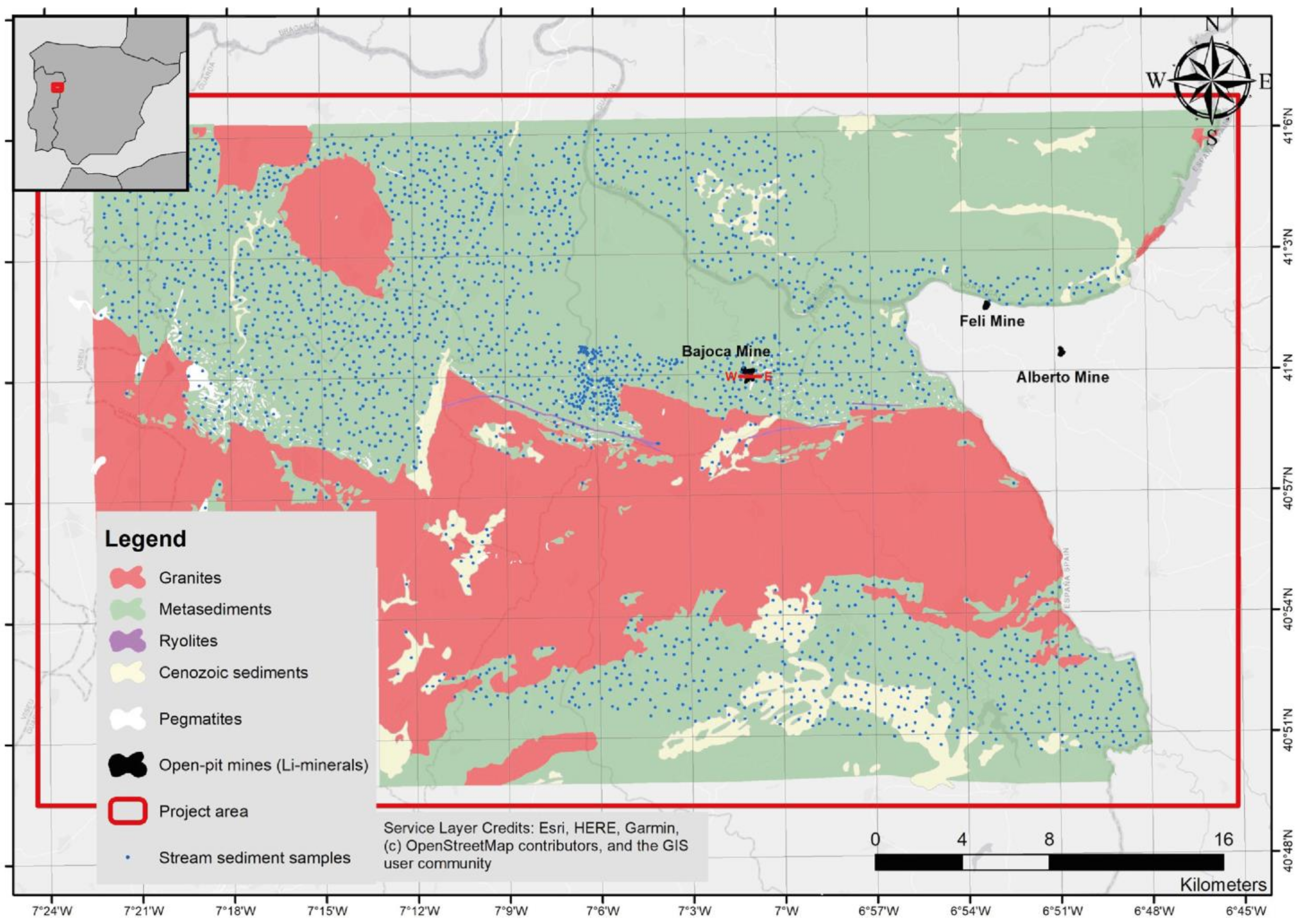
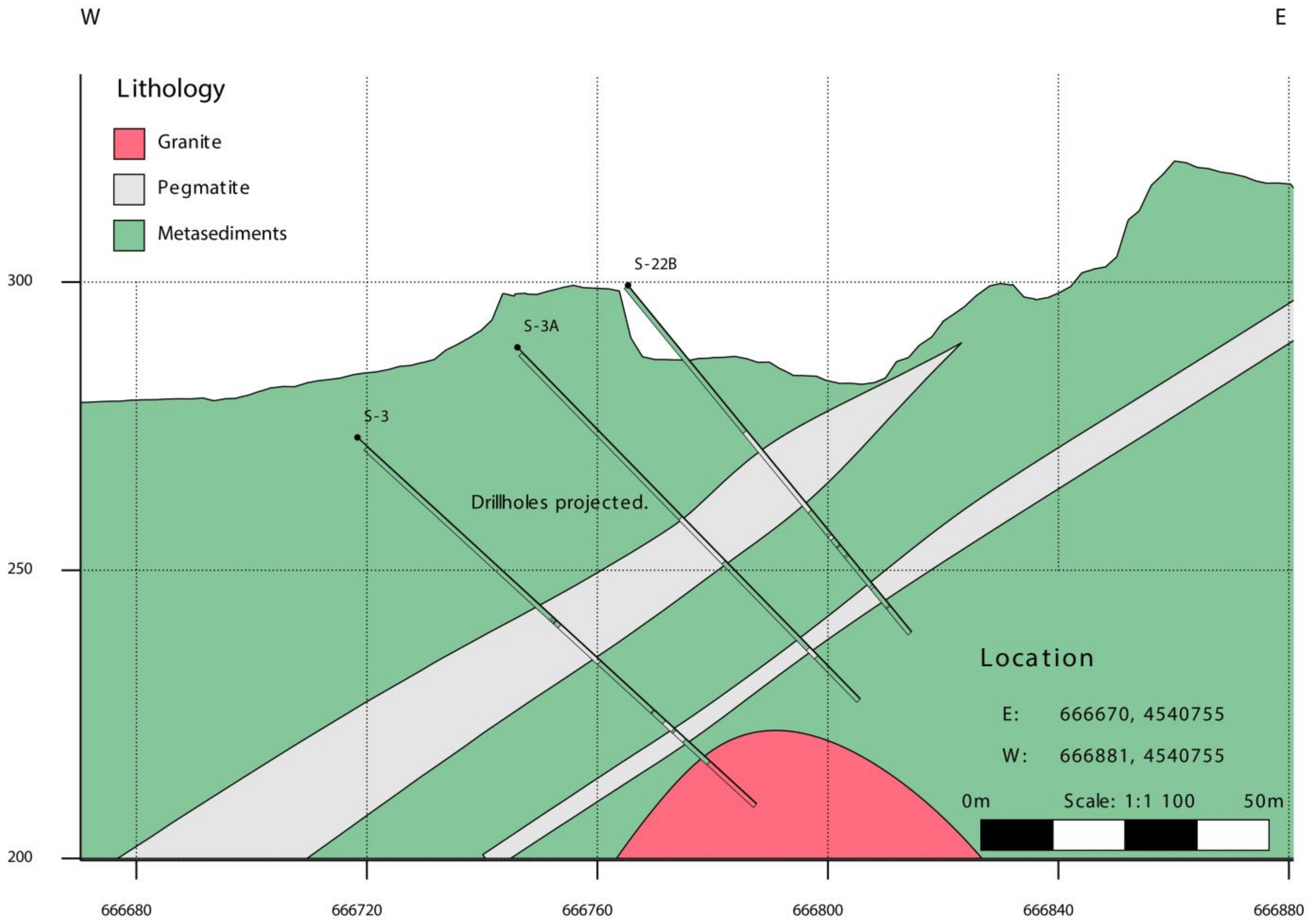

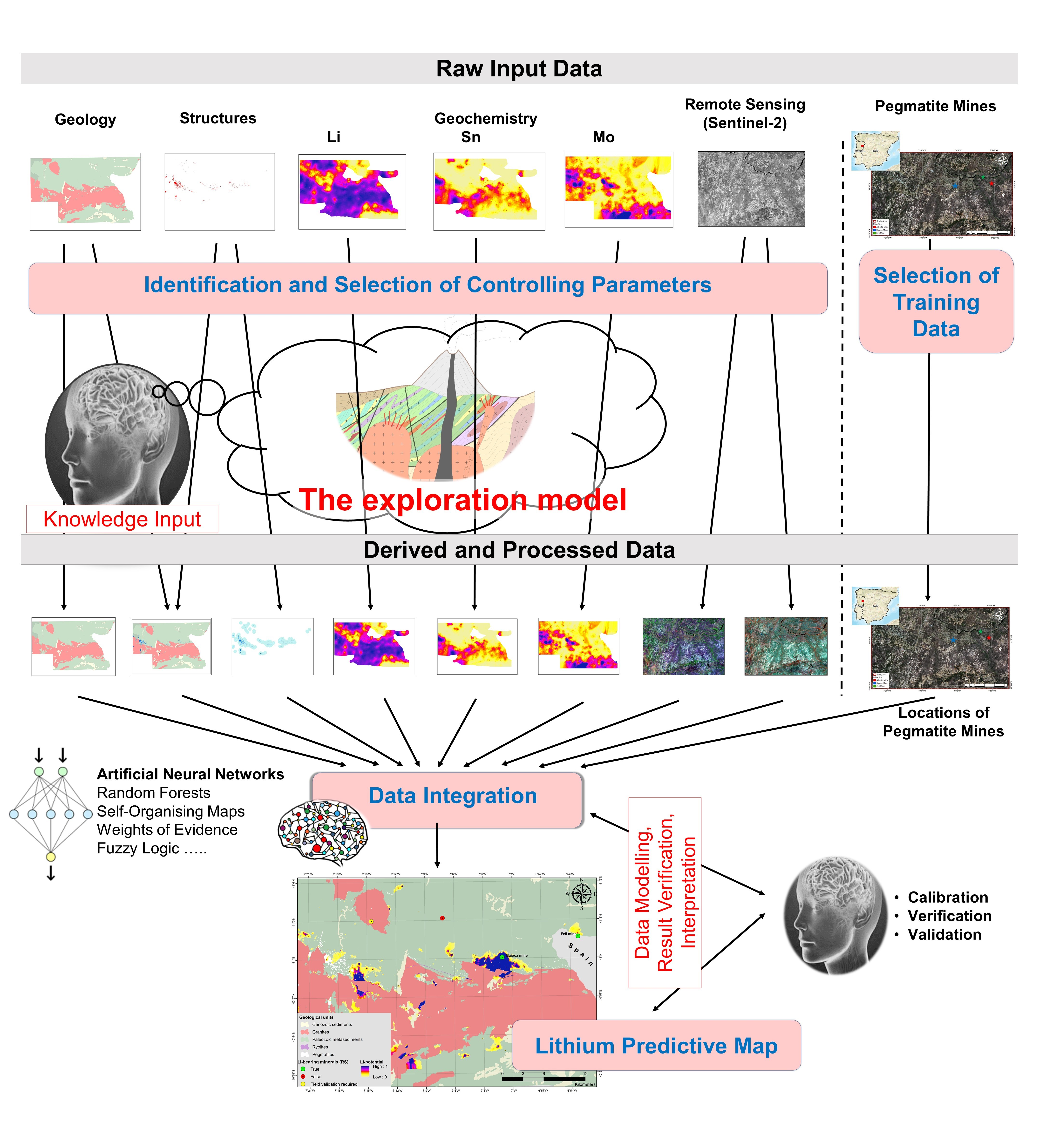
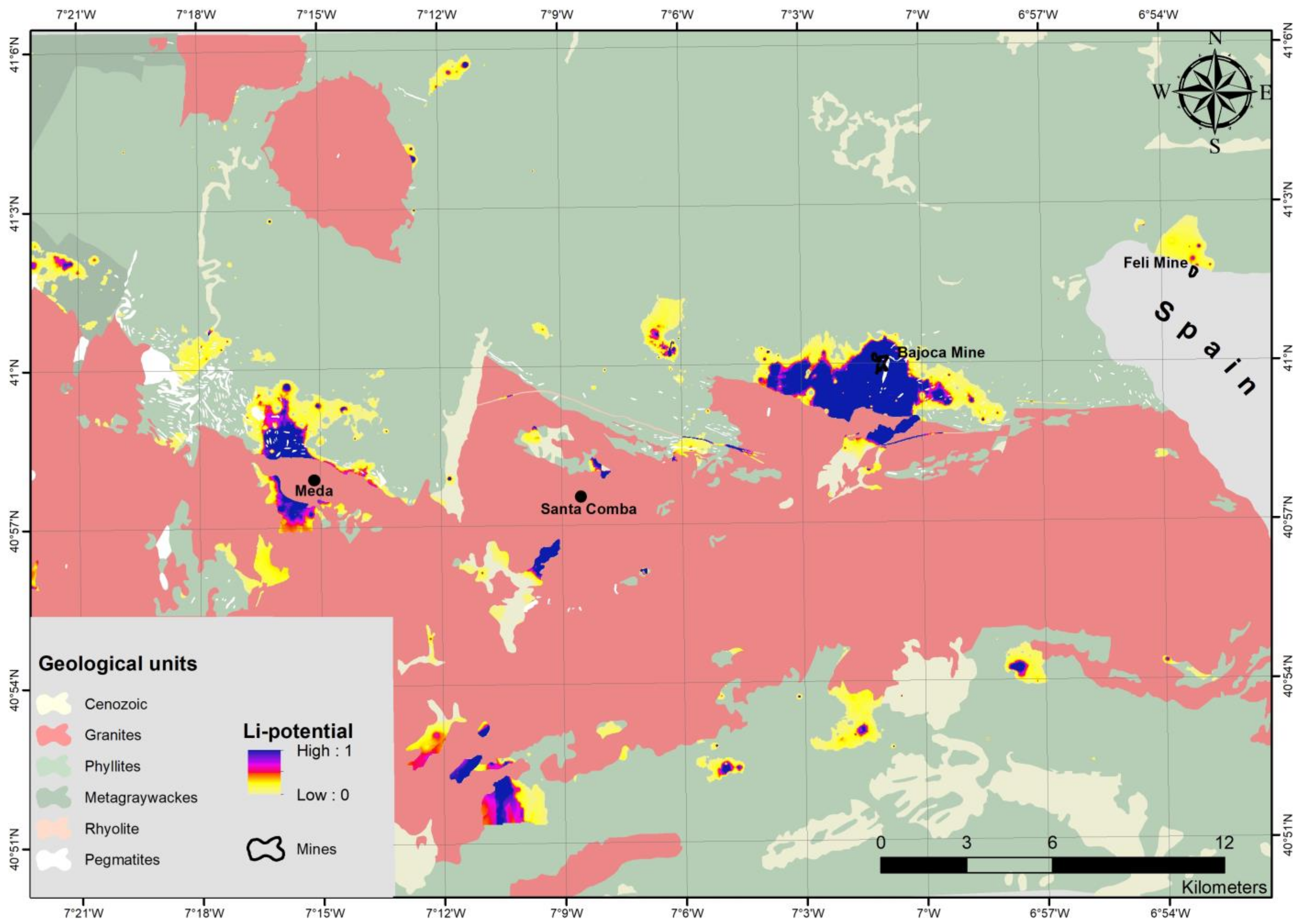

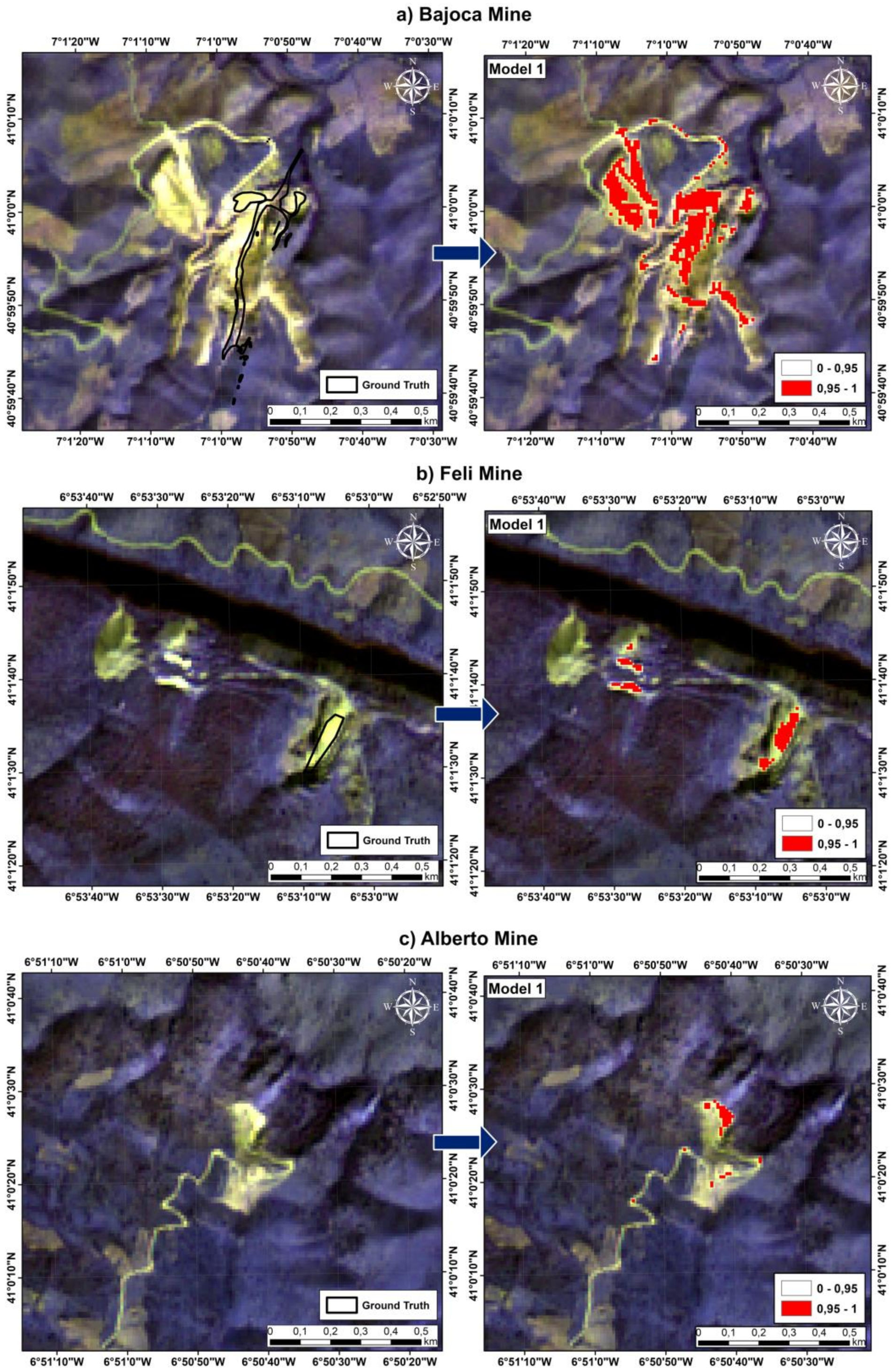


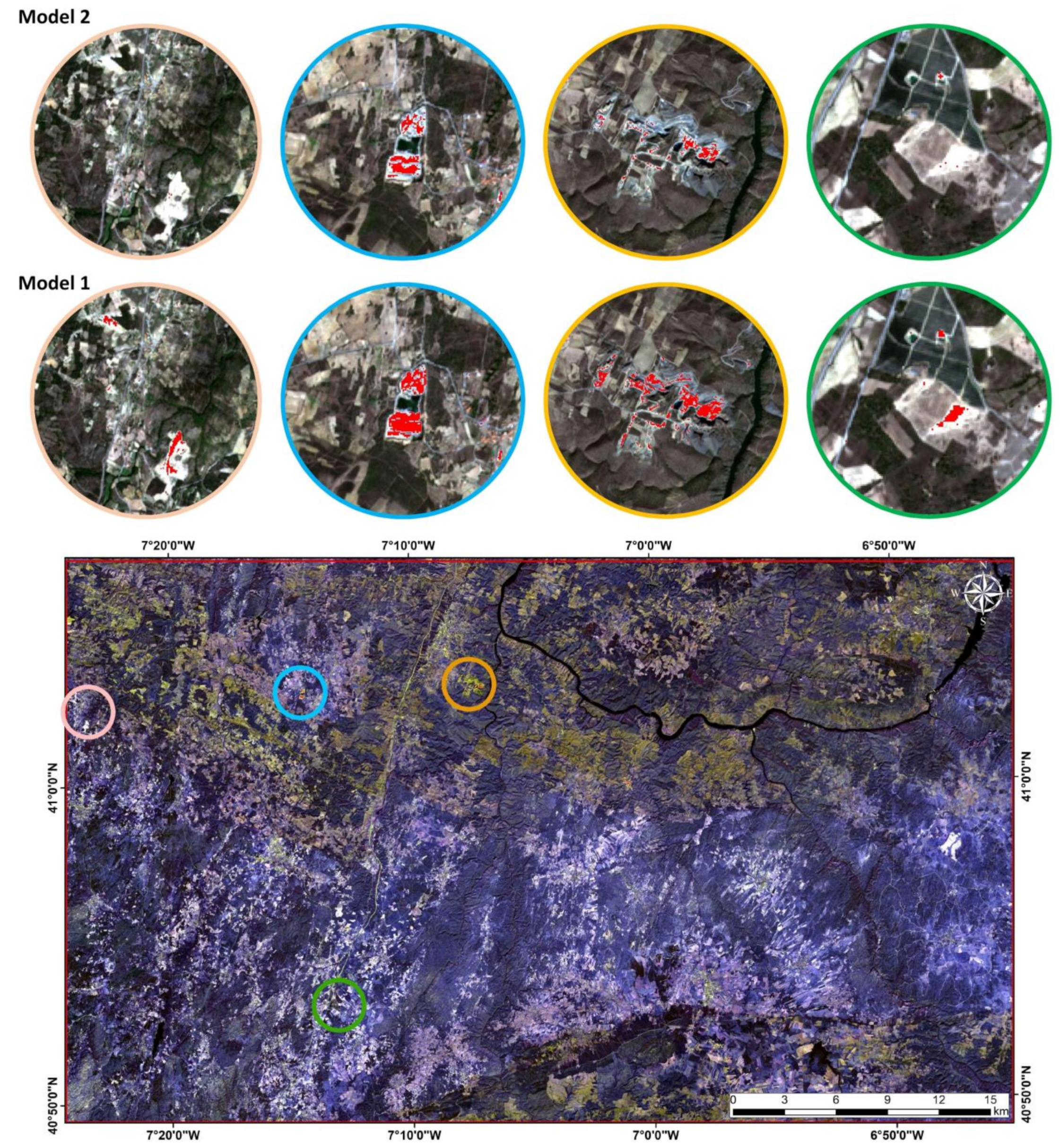

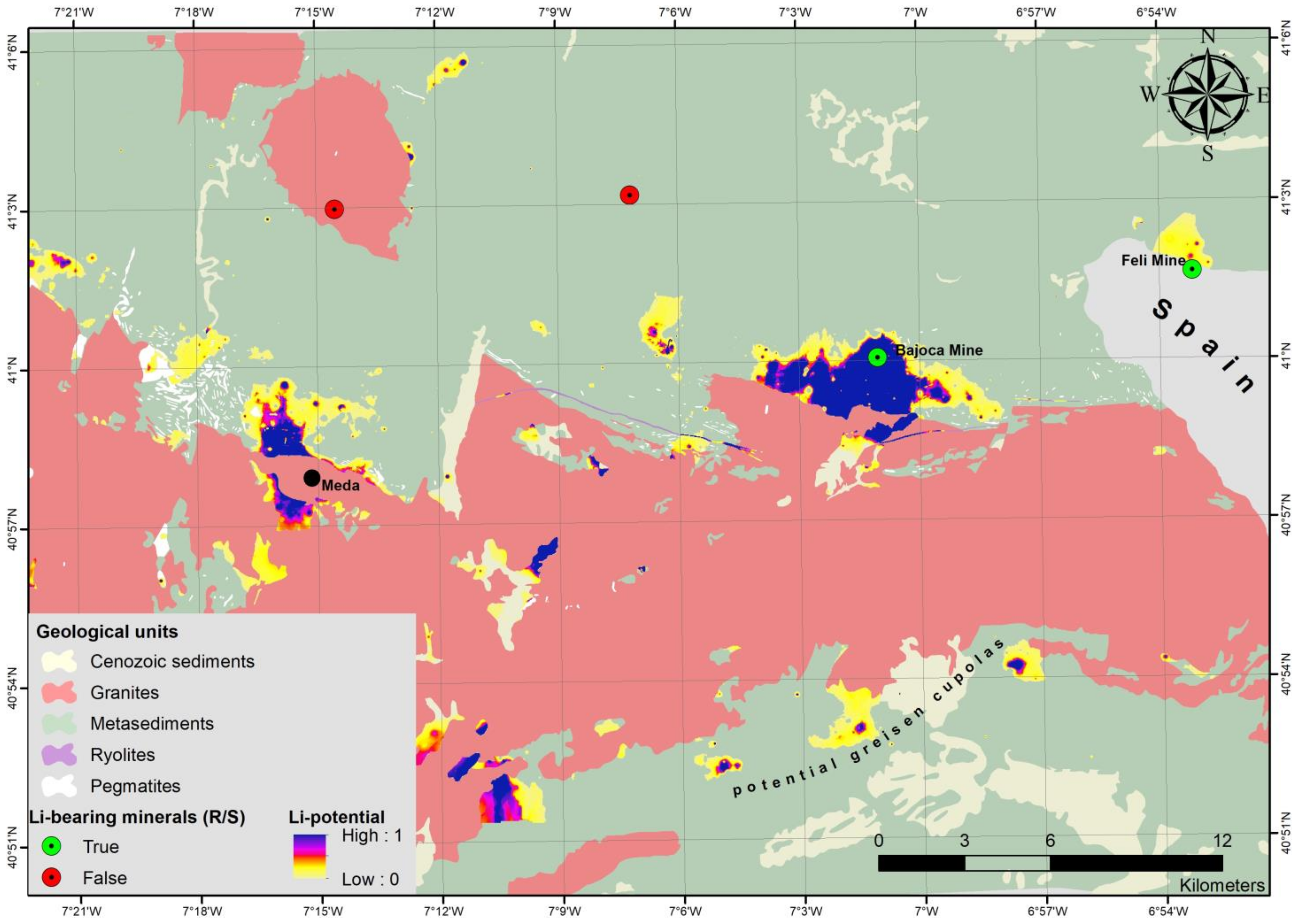
| Tile | Data Product | Spatial Resolution | Data Source | Reference System | Date of Acquisition | Cloud Coverage |
|---|---|---|---|---|---|---|
| T29TPF | 2A | 10m, 20m, 60m | ESA | UTM29N / WGS84 | 20191002 | 2.3% |
| Dimensionality Expansion | Formula |
|---|---|
| eB01–eB06 | √ (B2, B3, B4, B8, B11, B12) |
| eB07–eB12 | Log (B2, B3, B4, B8, B11, B12) |
| eB13–eB18 | (B2, B3, B4, B8, B11, B12)2 |
| eB19–eB33 | B02 × B03, B02 × B04, B02 × B08, B02 × B11, B02 × B12 B03 × B04, B03 × B08, B03 × B11, B03 × B12 B04 × B08, B04 × B11, B04 × B12 B08 × B11, B08 × B12 B11 × B12 |
| Extended Band | eB14 | eB15 | eB16 | eB24 | eB25 | eB28 | eB29 | eB31 |
|---|---|---|---|---|---|---|---|---|
| Formula | b3² | b4² | b8² | b3 × b4 | b3 × b8 | b4 × b8 | b4 × b11 | b8 × b11 |
| Parameter | Model 1 | Model 2 |
|---|---|---|
| Number of “positive” pixels | 12,088 | 3526 |
Publisher’s Note: MDPI stays neutral with regard to jurisdictional claims in published maps and institutional affiliations. |
© 2021 by the authors. Licensee MDPI, Basel, Switzerland. This article is an open access article distributed under the terms and conditions of the Creative Commons Attribution (CC BY) license (https://creativecommons.org/licenses/by/4.0/).
Share and Cite
Köhler, M.; Hanelli, D.; Schaefer, S.; Barth, A.; Knobloch, A.; Hielscher, P.; Cardoso-Fernandes, J.; Lima, A.; Teodoro, A.C. Lithium Potential Mapping Using Artificial Neural Networks: A Case Study from Central Portugal. Minerals 2021, 11, 1046. https://doi.org/10.3390/min11101046
Köhler M, Hanelli D, Schaefer S, Barth A, Knobloch A, Hielscher P, Cardoso-Fernandes J, Lima A, Teodoro AC. Lithium Potential Mapping Using Artificial Neural Networks: A Case Study from Central Portugal. Minerals. 2021; 11(10):1046. https://doi.org/10.3390/min11101046
Chicago/Turabian StyleKöhler, Martin, Delira Hanelli, Stefan Schaefer, Andreas Barth, Andreas Knobloch, Peggy Hielscher, Joana Cardoso-Fernandes, Alexandre Lima, and Ana C. Teodoro. 2021. "Lithium Potential Mapping Using Artificial Neural Networks: A Case Study from Central Portugal" Minerals 11, no. 10: 1046. https://doi.org/10.3390/min11101046
APA StyleKöhler, M., Hanelli, D., Schaefer, S., Barth, A., Knobloch, A., Hielscher, P., Cardoso-Fernandes, J., Lima, A., & Teodoro, A. C. (2021). Lithium Potential Mapping Using Artificial Neural Networks: A Case Study from Central Portugal. Minerals, 11(10), 1046. https://doi.org/10.3390/min11101046








